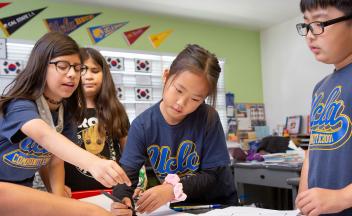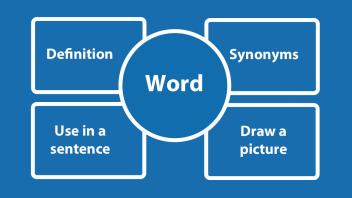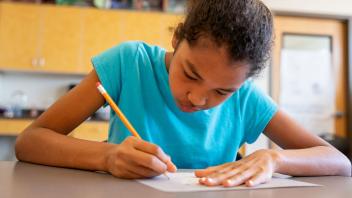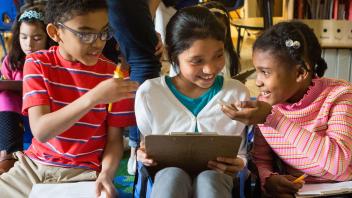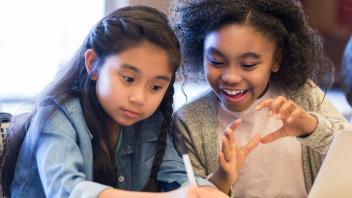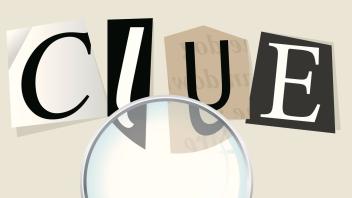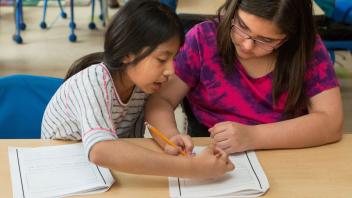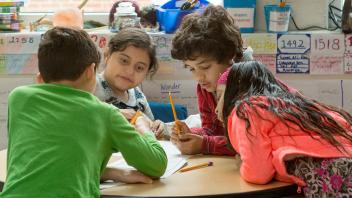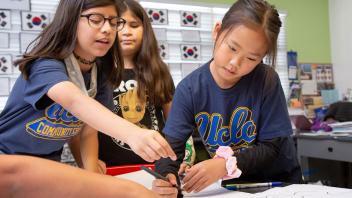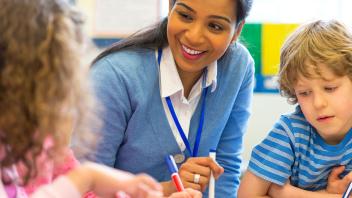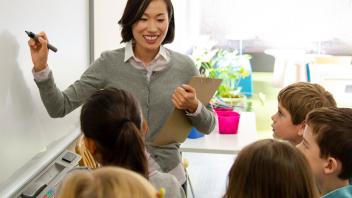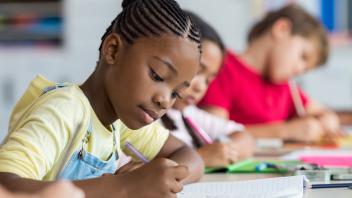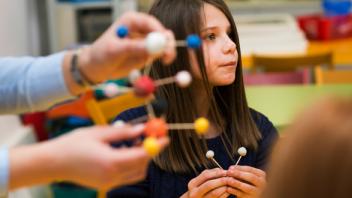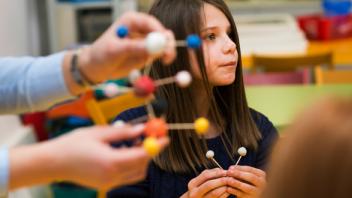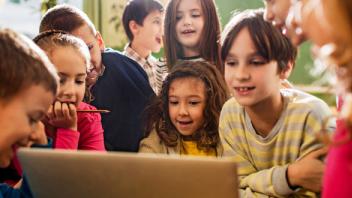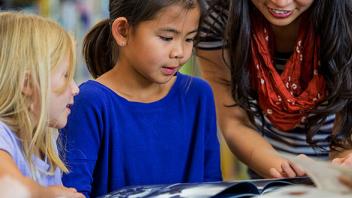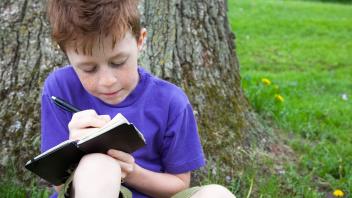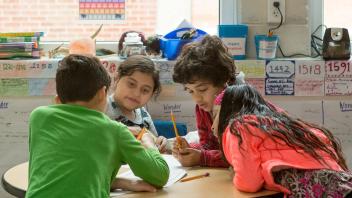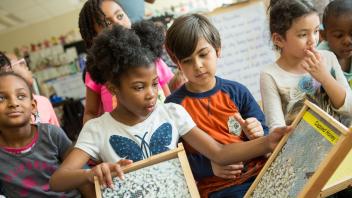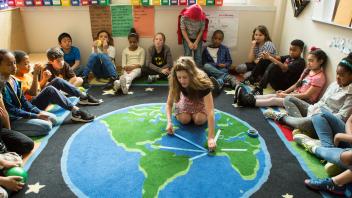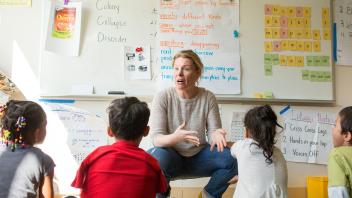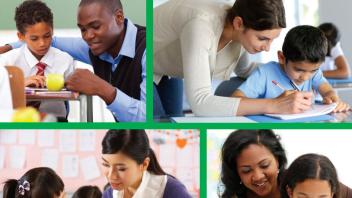What is content area literacy?
Content area literacy focuses on the listening, speaking, reading, and writing skills and thinking processes that help students learn from subject matter-specific texts. Evidence-based strategies such as pre-reading, activating prior knowledge, questioning, concept mapping, making inferences, re-reading, and summarizing that are often used inteaching English Language Arts can also be applied effectively across the content areas.
For example, in an elementary science unit, a teacher might use the jigsaw strategy in a study of rainforest animals. Jigsaw is a cooperative learning strategy that gives each student in a small group a chance to understand a topic more deeply and then share what they’ve learned with the group.
In an elementary social studies unit, a teacher might have students use inquiry charts to learn more about Ancient Egypt. The I-chart strategy asks students to generate meaningful questions about a topic, gather information from several sources, organize their writing, and share what they have learned.
All teachers — including content area teachers — are teachers of reading.”
How is disciplinary literacy different?
Disciplinary literacy focuses on reading and writing practices that are specific to their subjects — encouraging students to read and write like historians, biologists, engineers, mathematicians, and other subject-area experts.
Disciplinary literacy strategies could include building background knowledge specific to the discipline, learning specialized vocabulary, deconstructing complex discipline-specific text structures, providing visual data to support the text, asking discipline-specific questions, and providing evidence to support and evaluate claims (Lee and Spratley, 2010).
For example, how do historians use primary sources in their research and writing (including first person accounts), interpret conflicting points of view, and cite sources. Or how do scientists write a research paper — using discipline-specific vocabulary, detailed presentation of data (charts and graphs), and clear, precise statements of their hypothesis and results.
Does disciplinary literacy have a place in elementary school?
Literacy expert Tim Shanahan says that disciplinary literacy is generally taught in middle school and high school, but that K-5 teachers can get their students ready. Here’s how:
In the elementary grades, making sure that kids are reading about geography, economics, history, culture, biography, environmental science, life science, physical science, music, art, and current events is really important. Building kids’ stores of knowledge in those areas and giving them practice dealing with that kind of language and content is imperative.”
Shanahan encourages that we teach reading using social studies and science texts.
This can mean both including informational texts in the “reading books” and teaching reading using the regular textbooks from the subjects. If kids are going to practice prediction or summarizing or any other reading skill, why can’t they do that within Chapter 4 of the classroom science text?”
Literacy throughout the day
Literacy instruction goes beyond the time allotted for reading, writing, and spelling.
Listening, speaking, reading, and writing are necessary skills for most disciplines. Schools look for ways to extend reading, writing, and responding into content area instruction. Learning in math, science, social studies, and the arts is enhanced when teachers have students read and respond to expository texts.
The content areas build topic-specific knowledge necessary for reading comprehension.
Background knowledge is crucial to understand, to make connections, and to infer as we read. Lessons during science, social studies, and math contribute valuable vocabulary and ideas that support future reading comprehension.
Responding to content area reading is a social act.
The talk around texts and topics in pairs, triads, and groups helps students to make sense of new words and concepts. Sharing written responses with peers allows children to explain and evaluate their thinking collaboratively.
The same principles for effective reading instruction carry over to content reading.
Using strategies for before, during, and after reading supports students’ understanding of content-laden texts. Evidence-based practices such as activating prior knowledge, introducing a few key vocabulary words, using graphic organizers, and stopping occasionally to get the “gist” are examples of instructional practices that benefit all students, including your struggling readers and second language learners.
Inspire engagement and interest by featuring content area topics within your classroom library.
A classroom library filled with high-interest books on a wide range of reading levels and topics can encourage wide reading. Classroom libraries should include a variety of books, both fiction and nonfiction, that appeal to students’ interests and backgrounds. Teachers can build text sets around specific curriculum topics to encourage further exploration of content lessons.
Position Statement on the Role of Nonfiction Literature (K–12)
“Contemporary nonfiction for young people plays a crucial role in the reading and writing lives of K–12 students. It is a rich and compelling genre that supports students’ development as critically, visually, and informationally literate 21st century thinkers and creators.” Read more in this position statement from the National Council of Teachers of English. Position Statement on the Role of Nonfiction Literature (K–12)
Provide literacy supports to promote content area learning for diverse learners.
Remember the same strategies used to teach students how to read and write will work during your content area instruction. Don’t assume your students can read the textbook. Provide supplemental texts, video recordings, and multimedia texts to promote access to complex topics. Assess and preview key vocabulary and concepts. Use supports such as think-alouds to monitor students’ thinking and understanding.
Vocabulary, comprehension, and writing strategies
Content area reading skills build children’s general comprehension, writing, and study skills across areas of learning such as math, science, and social studies. Here are some reading and writing strategies with a strong research base that we can use within our content area instruction to support children as they gather, synthesize and comprehend information.
Content area literacy strategies
Watch a brief explanation of content area literacy and strategies for supporting content area reading and writing with students in the video below.
Classroom Strategy
Semantic Feature Analysis
Classroom Strategy
Listen-Read-Discuss
Classroom Strategy
Reciprocal Teaching
Classroom Strategy
List-Group-Label
Learning through text sets
Learning how to read and write like a historian or think like a mathematician can be challenging without a multitude of content area books and materials that children can read and interact with multiple times. This is no easy feat when resources are limited, but text sets can be an effective solution.
Text sets make content area learning accessible for all students by offering a collection of text and other materials on a topic or theme, including a mix of genres and reading levels. Instead of all children reading the same text, they explore music, speeches, and more as they delve into materials from diverse perspectives to deeply understand new content.
Sample text set from AdLit
Take a look at this text set on friendship from our sister site, AdLit. It includes conversation starters, quotes to prompt discussions and writing, anchor texts, music and videos, additional texts and resources, supports for recording and developing students’ ideas, writing prompts, and wrap-ups. Text Set: Friendship
Multimedia text sets: a how-to guide
Get the basics on how to create classroom text sets that support content-area literacy and building background knowledge. Multimedia Text Sets: A How-To Guide
Featured video
Learn more about content area literacy
Comprehension
Speaking and Listening in Content Area Learning
Common Core Standards
Content Area Vocabulary Learning
Common Core Standards
Using Multimedia to Teach Vocabulary: The Bridge That Leads to Deeper Understanding
Comprehension
Reading (and Scaffolding) Expository Texts
Comprehension
The Power of Quick Writes
Background Knowledge
Growing Knowledge Matters. A Lot.
Background Knowledge
Connect Students’ Background Knowledge to Content in the ELL Classroom
Shanahan on Literacy
Disciplinary Literacy Goes to Elementary School
Shanahan on Literacy
Disciplinary Literacy: The Basics
Additional web resources
- Text Sets: Building Knowledge and Vocabulary : Lessons using a volume of reading on specific topics to support all learners in building background knowledge and vocabulary (Achieve the Core)
- CommonLit: A website that offers a free collection of fiction and nonfiction texts for grades 3-12, aligned to state standards and organized by theme.
- Newsela: A website that delivers daily news articles at five different reading levels, along with comprehension quizzes and writing prompts for each article.
- Building Background Knowledge and Reading Proficiency: One Article at a Time (Text Project)
- Literacy Design Collaborative : A website from the department of education in Colorado that provides a framework and tools for designing rigorous literacy instruction across content areas and grade levels.
- Teaching Content-Area Literacy and Disciplinary Literacy (SEDL)
Guides and research reports
Browse our content area literacy resource library
Learn more about how to help kids build vocabulary, comprehension, and writing skills across the content areas. Here you’ll find articles, video, research briefs, web resources, and more. Visit our Content Area Literacy section
